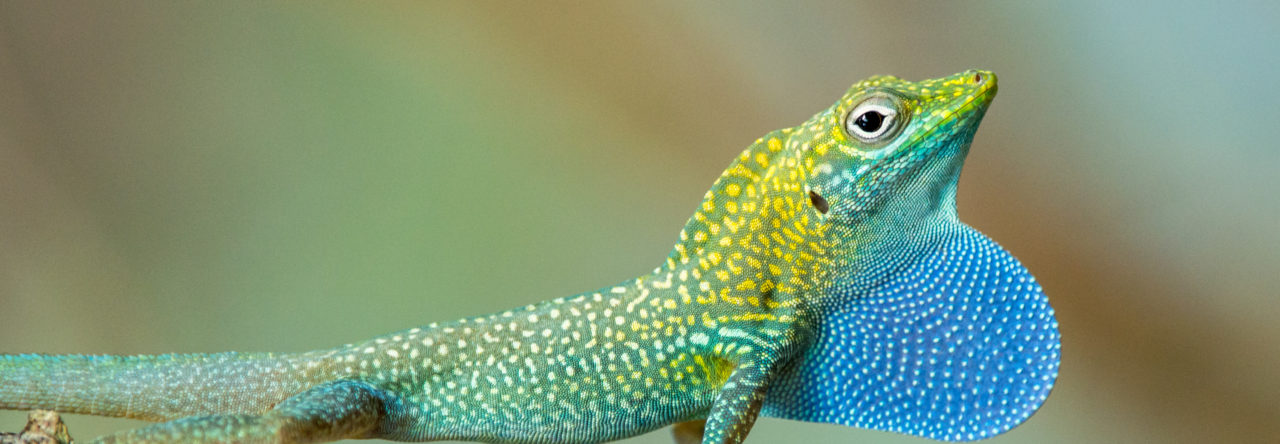Researchers have previously shown that anoles and other lizards will respond to moving robot lizards. In a recent elegant study in Herpetologica, Joe Macedonia and colleagues have used such robots to investigate what aspects of a lizard’s body or behavior are most important in eliciting responses. The work was conducted in Bermuda, where A. grahami and A. extremus were introduced from Jamaica and Barbados, respectively, in the first half of the last century.
 Macedonia and team built robots to look like these two species. It’s worth reading the details of how they built these realistic looking models: “We constructed a conspecific robot body and dewlap to resemble our study species, A. grahami, as well as a heterospecific robot body and dewlap to resemble A. extremus. Excluding the hind limbs and tail of each robot, which were made of airbrushed latex cast from lizard specimens (see Macedonia et al. 2013), each robot body was carved from a thick wooden dowel and attached to a servomotor pushrod. Anterior to the hind limbs, robots were covered with an image created in Adobe PhotoshopH from photos of the study species (Fig. 1). These images were mirrored and joined together at the body midline. Final images were printed onto adhesive-backed fabric and molded around the wooden body, which, together with the latex hindquarters, was attached to the polyvinyl chloride (PVC) perch. Dewlaps were fashioned from white, semitransparent guitar picks that fit into a slot carved in the neck of the robot body. A small hole that was drilled into the guitar pick was secured to a hinge pin that allowed it to pivot and extend. A second small hole in the pick allowed insertion of a thin wire that was attached to the pushrod, which in turn was attached to a servomotor.” The researchers were able to tune two servomotors to produce dewlap extension and head-bobbing patterns similar to those produced by each species. The following movies illustrate what the robots looked like.
Macedonia and team built robots to look like these two species. It’s worth reading the details of how they built these realistic looking models: “We constructed a conspecific robot body and dewlap to resemble our study species, A. grahami, as well as a heterospecific robot body and dewlap to resemble A. extremus. Excluding the hind limbs and tail of each robot, which were made of airbrushed latex cast from lizard specimens (see Macedonia et al. 2013), each robot body was carved from a thick wooden dowel and attached to a servomotor pushrod. Anterior to the hind limbs, robots were covered with an image created in Adobe PhotoshopH from photos of the study species (Fig. 1). These images were mirrored and joined together at the body midline. Final images were printed onto adhesive-backed fabric and molded around the wooden body, which, together with the latex hindquarters, was attached to the polyvinyl chloride (PVC) perch. Dewlaps were fashioned from white, semitransparent guitar picks that fit into a slot carved in the neck of the robot body. A small hole that was drilled into the guitar pick was secured to a hinge pin that allowed it to pivot and extend. A second small hole in the pick allowed insertion of a thin wire that was attached to the pushrod, which in turn was attached to a servomotor.” The researchers were able to tune two servomotors to produce dewlap extension and head-bobbing patterns similar to those produced by each species. The following movies illustrate what the robots looked like.
In the first experiment, wild A. grahami were presented with robots in the following four treatments: grahami color and grahami display patterns; grahami color and extremus display patterns; extremus color and grahami display patterns; and extremus color and display patterns.
Sixty-seven of 145 lizards responded to the displaying robots, and the strongest response was to the normal-looking grahami. In addition, the lizards dewlapped more to the robot with grahami color but extremus display pattern than they did to either of the robot treatments with extremus coloration; however, in terms of head-bobbing, the grahami did not distinguish between the three other treatments, responding similarly to all three at a lower headbobbing rate than to the normal- looking and behaving grahami robot.
In a second experiment, wild grahami were exposed to robots that looked like grahami and that: bobbed and dewlapped; only bobbed; or only dewlapped. Unexpectedly, they dewlapped the most to the robots that only dewlapped, and headbobbed the most to the robots that only headbobbed.
Macedonia et al. conclude the paper by suggesting that in the future, the best way to further this line of research will be to develop robots that can be controlled in real-time such that the robot’s behavior can be responsive to what the subject lizard does.












